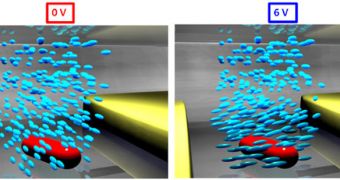Physicists at the Rice University were recently able to develop a new approach to controlling light scattered from gold nanorods. Their method relies on the use of liquid crystals in a way that has never been reported before, and that could enable a new generation of optical materials and metamaterials.
The goal of such investigations is to create materials that are capable of influencing light in a variety of ways. An added benefit would be to have the ability to control how these materials control photon streams at every turn, conceivably changing the properties of the material in real-time.
This is possible with metamaterial, engineered constructs that do not appear in nature. They are created in such a way that they are able to redirect the flow of photons, bending them around an object, or creating the blackest coating by absorbing more than 99 percent of incoming light.
With the new capability demonstrated by Rice chemist Stephan Link's team, it may be possible to augment the functions of these materials even further. In their latest study, the experts used voltages to control the alignment in a liquid crystal matrix.
The molecules can be made to alternatively block and allow light to pass through, depending on how many photons the researchers want the gold nanorods to receive and scatter. One of the most remarkable things in this system is that the nanorods can redirect light in a single, specified direction.
Details of this innovation appear in the latest issue of the American Chemical Society's (ACS) esteemed scientific journal Nano Letters. Link says that this approach was two years in the making, before Rice researchers were confident enough to present it to the world.
“The key to our approach is the in-plane rotation of liquid crystal molecules covering individual gold nanorods that act as optical antennas,” says the expert, who holds an appointment as an assistant professor of chemistry and electrical and computer engineering at the university.
“Learning how our devices work was exciting and has provided us with many ideas of how to manipulate light at the nanoscale,” Link goes on to say. He adds that the liquid crystal control device is an advanced, refined form of a standard half wave plate, an instrument controlling light polarization.
The study was made possible by funds secured from the Robert A. Welch Foundation, the Office of Naval Research, the American Chemical Society Petroleum Research Fund and a 3M Nontenured Faculty Grant.
Rice graduate students Saumyakanti Khatua, Pattanawit Swanglap and Jana Olson, as well as postdoctoral research associate Wei-Shun Chang, were all part of the study, and are listed as coauthors on the Nano Letters paper.

 14 DAY TRIAL //
14 DAY TRIAL //